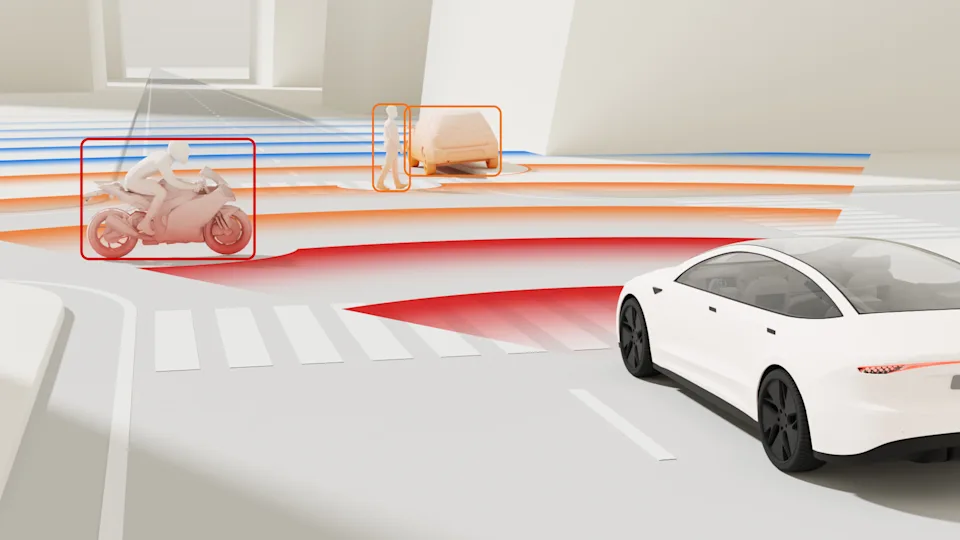地平線 LiDAR-Camera 融合多任務 BEVFusion 參考算法-V1.0
1.簡介
2.性能精度指標
模型參數:
模型數據集Input shapeLiDAR StreamCamera StreamBEV HeadOcc Head
| BEVFusion | Nuscenes | 圖像輸入:6x3x512x960點云輸入:1x5x20x40000 | CenterPoint | BEVFormer | BEVFormerDetDecoder | BevformerOccDetDecoder |
性能精度表現:
浮點**精度** NDS量化精度 NDSJ6E
| Latency/ms | FPS | ||
| 0.6428 | 0.6352 | 135.64 | 30.95 |
3.公版模型介紹
BEVFusion 主要由相機流、激光雷達流、動態融合模塊和檢測頭組成,下面將逐一進行介紹。
3.1 相機流
相機流將多視角圖像轉到 BEV 空間,由圖像編碼器、視覺投影模塊、BEV 編碼器組成。
3.1.1 圖像**編碼器**
圖像編碼器旨在將輸入圖像編碼為語義信息豐富的深度特征,它由用于基本特征提取的 2D backbone Dual-Swin-Tiny 和用于多尺度特征提取的 FPN 組成,并采用了一個簡單的功能自適應模塊 ADP 來完善上采樣功能,如下圖所示:
3.1.2 視覺投影模塊
視覺投影模塊采用 LSS 將圖像特征轉換為 3D 自車坐標,將圖像視圖作為輸入,并通過分類方式密集地預測深度。
然后,根據相機外參和預測的圖像深度,獲取偽體素。
3.1.3 BEV 編碼模塊
BEV 編碼模塊采用空間到通道(S2C)操作將 4D 偽體素特征編碼到 3D BEV 空間,從而保留語義信息并降低成本。然后又使用四個 3 × 3 卷積層縮小通道維度,并提取高級語義信息。
3.2 LiDAR 流
LiDAR 流將激光雷達點轉換為 BEV 空間,BEVFusion 采用 3 種流行的方法,PointPillars、CenterPoint 和 TransFusion 作為激光雷達流,從而展示模型框架的優秀泛化能力。
3.3 動態融合模塊
動態融合模塊的作用是將 concat 后的相機、 LiDAR 的 BEV 特進行有效融合。受 的啟發, BEVFusion 應用一個簡單的通道注意力模塊來選擇重要的融合特征,網絡結構圖如下所示:
4.地平線部署優化
地平線參考算法使用流程請參考附錄《TCJ6007-J6 參考算法使用指南》;對應高效模型設計建議請參考附錄《J6 算法平臺模型設計建議
4.1 優化點總結
整體情況:
BEVFusion 參考算法采用 BEVFormer 和 centerpoint 分別生成視覺和 LiDAR BEV 特征,然后使用 SE 模型融合 BEV 特征,最后將 BEV 特征解碼。
暫時無法在飛書文檔外展示此內容
改動點:
相機流使用了地平線深度優化后的 bevformer 參考算法,并將其轉換到 LiDAR 坐標系,其相對于公版的優化如下:
使用地平線深度優化后的高效 backbone HENet 提取圖像特征;
將 attention 層的 mean 替換為 conv 計算,使性能上獲得提升;
公版模型中,在 Encoder 的空間融合模塊,會根據 bev_mask 計算有效的 query 和 reference_points,輸出 queries_rebatch 和 reference_points_rebatch,作用為減少交互的數據量,提升模型運行性能。對于稀疏的 query 做 crossattn 后再將 query 放回到 bev_feature 中。;
修復了公版模型中時序融合的 bug,并獲得了精度上的提升,同時通過對關鍵層做 int16 的量化精度配置以保障 1%以內的量化精度損失。
LiDAR 流采用了地平線深度優化后的 centerpoint 參考算法,其相對于公版的優化如下:
前處理部分的輸入為 5 維點云并做歸一化處理,對量化訓練更加友好;
PillarFeatutreNet 中的 PFNLayer 使用 Conv2d + BatchNorm2d + ReLU,替換原有的 Linear + BatchNorm1d + ReLU,使該結構可在 BPU 上高效支持,實現了性能提升;
PillarFeatutreNet 中的 PFNLayer 使用 MaxPool2d,替換公版的 torch.max,便于性能的提升;
Scatter 過程使用 horizon_plugin_pytorch 優化實現的 point_pillars_scatter,便于模型推理優化,邏輯與 torch 公版相同;
對于耗時嚴重的 OP,采用 H、W 維度轉換的方式,將較大維數放到 W 維度,比如 1x5x40000x20 轉換為 1x5x20x40000;
相對于公版,增加了 OCC 任務頭,實現了 LiDAR+Camera+OCC 動靜態二網合一;
4.2 性能優化4.2.1 相機流
公版 BEVFusion 使用流行的 Lift-Splat-Shoot(LSS)并適度調整以提高性能。參考算法直接采用了地平線深度優化后的 BEVFormer 參考算法作為相機流網絡,bev 網格的尺寸配置為 128 x128。
改動點 1:
backbone 由公版的 Dual-Swin-Tiny 替換為地平線的高效 backbone HENet,不僅在精度上可與 ResNet50 相媲美,而且在性能上有顯著優勢。
HENet 是針對 征程 6 平臺專門設計的高效 backbone,其采用了純 CNN 架構,總體可分為四個 stage,每個 stage 會進行 2 倍下采樣。以下為總體的結構配置:
depth = [4, 3, 8, 6]
block_cls = ["GroupDWCB", "GroupDWCB", "AltDWCB", "DWCB"]
width = [64, 128, 192, 384]
attention_block_num = [0,0,0,0]
mlp_ratios, mlp_ratio_attn = [2, 2, 2, 3], 2
act_layer = ["nn.GELU", "nn.GELU", "nn.GELU", "nn.GELU""]
use_layer_scale = [True,True,True,True]
final_expand_channel, feature_mix_channel = 0,1024
down_cls = ["S2DDown", "S2DDown", "S2DDown", "None"71
模型相關細節可以參考。
代碼路徑:/usr/local/lib/python3.10/dist-packages/hat/models/backbones/henet.py
改動點 2:
bevformer 中的Temporal Self-Attention通過引入時序信息與當前時刻的 BEV Query 進行融合,提高 BEV Query 的建模能力,Temporal Self-Attention中最關鍵的結構為MultiScaleDeformableAttention。
經評估,該模塊中的 mean 對性能影響較大,參考算法中將其替換為固定 weight 的 conv 計算,從而獲取性能上的提升,相關代碼:
class HorizonTemporalSelfAttention(MultiScaleDeformableAttentionBase):
"""The basic structure of HorizonTemporalSelfAttention.
Args:
embed_dims: The embedding dimension of Attention.
num_heads: Parallel attention heads.
num_levels: The num of featuremap.
num_points: The num points for each head sample.
grid_align_num: The align num for grid, align the grid shape of \
gridsample operator to \
[bs * numhead, -1, grid_align_num * numpoints, 2].
num_bev_queue: The num queue for temporal fusion.
reduce_align_num: The align num for reduce mean, align the shape to \
[bs, num_bev_queue * reduce_align_num, -1, num_query].
dropout: Probability of an element to be zeroed.
feats_size: The Size of featmaps.
"""
def
__init__
(
self,
embed_dims: int = 256,
num_heads: int = 8,
num_levels: int = 4,
num_points: int = 4,
grid_align_num: int = 8,
num_bev_queue: int = 2,
reduce_align_num: int = 1,
dropout: float = 0.1,
feats_size: Sequence[Sequence[int]] = ((128, 128),),
) -> None:
super().
__init__
(
embed_dims=embed_dims,
num_heads=num_heads,
num_levels=num_levels,
num_points=num_points,
grid_align_num=grid_align_num,
feats_size=feats_size,
)
self.dropout = nn.Dropout(dropout)
self.num_bev_queue = num_bev_queue
self.reduce_align_num = reduce_align_num
...
#將mean計算替換為conv計算
self.query_reduce_mean = nn.Conv2d(
self.num_bev_queue * self.reduce_align_num,
self.reduce_align_num,
1,
bias=False,
)
代碼路徑:/usr/local/lib/python3.10/dist-packages/hat/models/task_modules/bevformer/attention.py
改動點 3:
Spatial Cross-Attention利用 Temporal Self-Attention 模塊輸出的 bev_query, 對主干網絡和 Neck 網絡提取到的多尺度環視圖像特征進行查詢,生成 BEV 空間下的BEV Embedding特征。公版的 BEVFormer 中采用 bevmask 來減少 camera 的 query 點數的優化,但是由于涉及到 BPU 不支持的動態 shape,并且涉及到運行效率較低的 gather/scatter 操作(當前 gather 算子已經支持 BPU 加速)。進一步分析發現:
從 bev voxel 的角度來看,中心點到 multi camera 的映射是稀疏的;
從 bev pillar 的角度來看,通常每個 pillar 只會映射到 1-2 個 camera;
基于以上分析以及實驗結果,參考算法在設置了virtual_bev_h、virtual_bev_w、max_numcam_overlap這 3 個參數對稀疏率進行配置,這 3 個參數的具體含義是:
virtual_bev_h:虛擬 bev 的高度,用于計算將稀疏點集恢復為密集 bev 的網格,參考算法中配置為 64;
virtual_bev_w:虛擬 bev 的寬度,用于計算將稀疏點集恢復為密集 bev 的網格,參考算法中配置為 80;
max_numcam_overlap:每個 bev pillar 映射到的最多 camera 數量,參考算法中配置為 2;
view_transformer=dict(
type="SingleBevFormerViewTransformer",
bev_h=bev_h_,
bev_w=bev_w_,
pc_range=point_cloud_range,
num_points_in_pillar=2,
embed_dims=
_dim_
,
queue_length=1,
in_indices=(-1,),
single_bev=True,
use_lidar2img=use_lidar2img,
max_camoverlap_num=max_camoverlap_num, #2
virtual_bev_h=64,
virtual_bev_w=80,
positional_encoding=dict(
type="LearnedPositionalEncoding",
num_feats=
_pos_dim_
,
row_num_embed=bev_h_,
col_num_embed=bev_w_,
),
代碼路徑:samples/ai_toolchain/horizon_model_train_sample/scripts/configs/lidar_bevfusion/bevfusion_pointpillar_henet_multisensor_multitask_nuscenes.py
4.2.2 LiDAR 流
公版 BEVFusion 采用了當前流行的 3 種激光點云檢測模型 PointPillars , CenterPoint 和 TransFusion 作為 LiDAR 流來展示框架的通用性。BEVFusion 參考算法復用了經過深度優化的 centerpoint 參考算法,其相對于公版主要做了以下性能優化,下面將逐一介紹。
改動點 1:
為了應用 2D 卷積架構,PillarFeatutreNet 將點云(P,N,5)轉換為 2D 偽圖像,整體步驟如下圖所示:
公版模型中 PillarFeatutreNet 中的部分算子在 BPU 運行效率比較低,所以參考算法對其做了替換:
PillarFeatutreNet 中的 PFNLayer 使用 BPU 上運行比較高效的 Conv2d + BathNorm2d + ReLU 算子,替換了公版的 Linear + BatchNorm1d + ReLU 結構,實現了性能的提升;
PillarFeatutreNet 中的 PFNLayer 使用 MaxPool2d,替換原有的 torch.max,便于性能的提升,對應代碼:
class PFNLayer(nn.Module):
def
__init__
(
self,
in_channels: int,
out_channels: int,
bn_kwargs: dict = None,
last_layer: bool = False,
use_conv: bool = True,
pool_size: Tuple[int, int] = (1, 1),
hw_reverse: bool = False,
):
"""Pillar Feature Net Layer.
This layer is used to convert point cloud into pseudo-image.
Can stack multiple to form Pillar Feature Net.
The original PointPillars paper uses only a single PFNLayer.
Args:
in_channels (int): number of input channels.
out_channels (int): number of output channels.
bn_kwrags (dict): batch normalization arguments. Defaults to None.
last_layer (bool, optional): if True, there is no concatenation of
layers. Defaults to False.
"""
...
if not self.use_conv:
...
else:
#使用Conv2d + BathNorm2d + ReLU,
#替換了公版的 Linear + BatchNorm1d + ReLU
self.linear = nn.Conv2d(
in_channels, self.units, kernel_size=1, bias=False
)
self.norm = nn.BatchNorm2d(self.units, **bn_kwargs)
self.relu = nn.ReLU(inplace=True)
#使用 MaxPool2d,替換torch.max
self.max_pool = nn.MaxPool2d(
kernel_size=pool_size, stride=pool_size
)
代碼路徑:/usr/local/lib/python3.10/dist-packages/hat/models/task_modules/lidar/pillar_encoder.py
改動點 2:
如上圖所示,Scatter 是實現偽圖像轉換的重要一個步驟,參考算法使用horizon_plugin_pytorch實現的point_pillars_scatter,便于模型推理優化,邏輯與公版相同。對應代碼:
from horizon_plugin_pytorch.nn.functional import point_pillars_scatter
class PointPillarScatter(nn.Module):
...
def forward(
...
):
#input_shape=(coors_range[3:] - coors_range[:3]) / voxel_size
self.nx = input_shape[0]
self.ny = input_shape[1]
if self.use_horizon_pillar_scatter: #對應改動4
if len(voxel_features.shape) == 4:
P, C = voxel_features.size(2), voxel_features.size(3)
voxel_features = voxel_features.reshape(P, C)
out_shape = (batch_size, self.nchannels, self.ny, self.nx)
#(P, C)-->(batch,C,H,W)
batch_canvas = point_pillars_scatter(
voxel_features, coords, out_shape
)
else:
...
return batch_canvas
其中,核心函數point_pillars_scatter是在horizon_plugin_pytorch中實現的。
代碼路徑: /usr/local/lib/python3.10/dist-packages/hat/models/task_modules/lidar/pillar_encoder.py
4.2.3 動態融合模塊
相對于公版的動態融合模塊(參考 3.3 節),參考算法在 concat 后新增了 1 個 conv1x1,有助于性能的提升,相關代碼如下:
class BevFuseModule(nn.Module):
"""BevFuseModule fuses features using convolutions and SE block.
Args:
input_c: The number of input channels.
fuse_c: The number of channels after fusion.
"""
def
__init__
(self, input_c: int, fuse_c: int):
super().
__init__
()
self.reduce_conv = ConvModule2d(
input_c,
fuse_c,
kernel_size=1,
stride=1,
padding=0,
norm_layer=nn.BatchNorm2d(fuse_c, eps=1e-3, momentum=0.01),
act_layer=nn.ReLU(inplace=False),
...
def forward(self, x: torch.Tensor):
#增加了 conv1x1
x = self.reduce_conv(x)
x = self.conv2(x)
pts_feats = self.seblock(x)
return pts_feats
代碼路徑: /usr/local/lib/python3.10/dist-packages/hat/models/task_modules/lidar_fusion/fusion_module.py
4.3 浮點精度優化4.3.1 旋轉增強
在模型訓練時,參考算法對 bev 進行旋轉增強,相關代碼如下:
train_dataset = dict(
type="NuscenesBevSequenceDataset",
data_path=os.path.join(data_rootdir, "train_lmdb"),
...
transforms=[
dict(type="MultiViewsImgResize", size=input_size),
dict(type="MultiViewsImgFlip"),
dict(type="MultiViewsImgRotate", rot=(-5.4, 5.4)),
dict(type="BevBBoxRotation", rotation_3d_range=(-0.3925, 0.3925)),
dict(type="MultiViewsPhotoMetricDistortion"),
dict(
type="MultiViewsImgTransformWrapper",
transforms=[
dict(type="PILToTensor"),
dict(type="BgrToYuv444", rgb_input=True),
dict(type="Normalize", mean=128, std=128),
],
),
],
)
代碼路徑:
horizon_model_train_sample/scripts/configs/lidar_bevfusion/bevfusion_pointpillar_henet_multisensor_multitask_nuscenes.py
/usr/local/lib/python3.10/dist-packages/hat/data/transforms/multi_views.py
4.3.2 加載預訓練模型
為了提升浮點模型的精度,浮點訓練時相機流和 LiDAR 流分別加載了預訓練模型,然后再共同訓練,對應代碼如下:
float_trainer = dict( type="distributed_data_parallel_trainer", model=model, data_loader=data_loader, model_convert_pipeline=dict( type="ModelConvertPipeline", converters=[ dict( type="LoadCheckpoint", #加載相機流的預訓練模型 checkpoint_path=os.path.join( camera_ckpt_dir, "float-checkpoint-last.pth.tar" ), allow_miss=True, ignore_extra=True, verbose=True, ), dict( type="LoadCheckpoint", #加載LiDAR流的預訓練模型 checkpoint_path=os.path.join( lidar_ckpt_dir, "float-checkpoint-last.pth.tar" ), ... ),
代碼路徑:
horizon_model_train_sample/scripts/configs/lidar_bevfusion/bevfusion_pointpillar_henet_multisensor_multitask_nuscenes.py
4.4 量化精度優化4.4.1 全 int8+部分算子配置為 int16
BEVFusion 參考算法采用的量化策略為全 int8+部分敏感算子通過 set_qconfig 配置為 int16,其中敏感算子的集中分布在 bevformer 部分,如下為 bevformer 中將MultiScaleDeformableAttention中對量化敏感的算子和 Tensor 配置為 int16 的示例代碼:
class MultiScaleDeformableAttentionBase(nn.Module):
"""The basic class for MultiScaleDeformableAttention.
Args:
embed_dims: The embedding dimension of Attention.
num_heads: Parallel attention heads.
num_levels: The num of featuremap.
num_points: The num points for each head sample.
grid_align_num: The align num for grid, align the grid shape of \
gridsample operator to \
[bs * numhead, -1, grid_align_num * numpoints, 2].
feats_size: The Size of featmaps.
"""
def
__init__
(
self,
embed_dims: int = 256,
num_heads: int = 8,
num_levels: int = 4,
num_points: int = 4,
grid_align_num: int = 8,
feats_size: Sequence[Sequence[int]] = ((128, 128),),
) -> None:
super().
__init__
()
...
def set_qconfig(self) -> None:
"""Set the quantization configuration."""
from hat.utils import qconfig_manager
int16_module = [
self.sampling_offsets,
self.quant_shape,
self.norm_offset,
self.add_offset,
self.add1,
self.mul1,
]
for m in int16_module:
m.qconfig = qconfig_manager.get_qconfig(
activation_qat_qkwargs={"dtype": qint16},
activation_calibration_qkwargs={
"dtype": qint16,
},
activation_calibration_observer="mix",
)代碼路徑:
/usr/local/lib/python3.10/dist-packages/hat/models/task_modules/bevformer/attention.py
4.5 其它優化4.5.1 增加 Occ 任務頭
除了公版 BEVFusion 就存在的 3D 檢測頭外,參考算法增加了 Occ 任務頭做占用預測,和 3D 檢測頭共用特征部分,從而極大地節省了計算資源。Occ 任務頭復用了中的 head 進行設計,通過通道轉高度模塊將 BEV 特征沿通道維度執行簡單的重塑操作。相關代碼如下:
def forward(self, img_feats: Tensor): """Forward mould. Args: img_feats: (B, C, Dy, Dx) Returns: occ_pred:tensor """ occ_pred = self.final_conv(img_feats) if self.use_upsample is True: occ_pred = F.interpolate( occ_pred, size=(200, 200), mode="bilinear", align_corners=False ) # (B, C, Dy, Dx) --> (B, Dx, Dy, C) occ_pred = occ_pred.permute(0, 3, 2, 1) bs, Dx, Dy = occ_pred.shape[:3] if self.use_predicter: #通道轉高度操作 # (B, Dx, Dy, C) --> (B, Dx, Dy, 2 *C) --> (B, Dx, Dy, Dz* n_cls) occ_pred = self.predicter(occ_pred) occ_pred = occ_pred.view(bs, Dx, Dy, self.Dz, self.num_classes) return occ_pred
代碼路徑:
/usr/local/lib/python3.10/dist-packages/hat/models/task_modules/flashocc/bev_occ_head.py
Occ label 坐標轉換
由于 Occ label 是在 ego 坐標系中標注的,所以需要將其統一到 Lidar 坐標系,相關代碼如下:
class NuscenesBevDataset(NuscenesDataset): ... def __getitem__ (self, item): aug_cfg = None if isinstance(item, dict): idx = item["idx"] aug_cfg = item["aug"] else: idx = item sample = self._decode(self.pack_file, self.samples[idx]) sample = NuscenesSample(sample) data = self.sampler(sample) if aug_cfg: data["scenes_aug"] = aug_cfg if self.transforms is not None: data = self.transforms(data) if self.with_lidar_occ: #將Occ label由ego坐標系轉到lidar坐標系 data["gt_occ_info"] = sample._get_lidar_occ(data["lidar2global"]) return data
代碼路徑:
/usr/local/lib/python3.10/dist-packages/hat/data/datasets/nuscenes_dataset.py
Bev 特征裁剪
bev 的空間范圍為[51.2,51.2],grid 尺寸為 128x128;而 occ 的空間范圍為[40,40],grid 尺寸為 128x128。為了將 bev 空間范圍對齊到 Occ,occ_head中根據比例將 128x128 的 bev feature 從中心裁剪出 100x100 的 roi,從而滿足 40/51.2=100/128。相關代碼如下:
occ_head = dict( type="BevformerOccDetDecoder", use_mask=True, lidar_input=lidar_input, camera_input=camera_input, num_classes=num_classes_occ, #使用RoiResize做bev feature的裁剪 roi_resizer=dict( type="RoiResize", in_strides=[1], roi_resize_cfgs=[ dict( in_stride=1, roi_box=(14, 14, 114, 114), ) ], ),
代碼路徑:
horizon_model_train_sample/scripts/configs/lidar_bevfusion/bevfusion_pointpillar_henet_multisensor_multitask_nuscenes.py
5.總結與建議5.1 訓練建議
建議在浮點訓練時分別加載 Lidar 流和相機流的預訓練模型,然后再訓練整個網絡;
建議選擇合適的 bev grid size,實驗中發現 bev grid size 配置為 128x128 時的精度比 50x50 要高;
對于多任務模型,建議在量化訓練適當增加 epoch,即量化訓練不一定要嚴格按照浮點訓練的 1/10 epoch 來訓練;
浮點訓練時采用CosineAnnealingLrUpdater策略,量化訓練時采用StepDecayLrUpdater策略,對于此模型來說,采用StepDecayLrUpdater策略對量化訓練精度更友好;
5.2 部署建議
建議在模型架構設計之初就考慮采用地平線深度優化后的 backbone 或者網絡作為 base model;
在注意力機制中存在一些 add、sum 等 ElementWise 操作,對于導致性能瓶頸的可以考慮 conv 替換,對于造成量化風險的可以根據敏感度分析結果合理選擇更高的量化精度,以確保注意力機制的部署;
建議在選擇 bev size 時考慮性能影響。征程 6 相比于 征程 5 帶寬增大,但仍需注意 bev size 過大導致訪存時間過長對性能的影響,建議考慮實際部署情況選擇合適的 bev size;
若出現性能問題可以通過優化 backbone 或者減少層數或者點數的方式來提升性能,但要注意以上操作可能會導致精度損失,請優先考慮對點數的減少等對精度的影響較小性能收益最高的操作;
附錄
論文:
公版模型代碼:https://github.com/ADLab-AutoDrive/BEVFusion
參考算法使用指南:
*博客內容為網友個人發布,僅代表博主個人觀點,如有侵權請聯系工作人員刪除。










